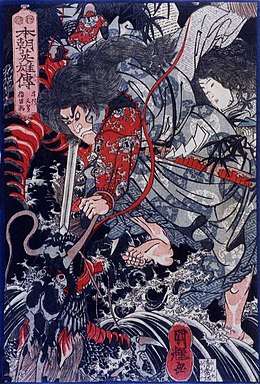Tsukuyomi-no-Mikoto
Tsukuyomi-no-Mikoto (月読尊) or Tsukuyomi (月読), is the moon god in Shinto and Japanese mythology. The name "Tsukuyomi" is a compound of the Old Japanese words tsuku (月, "moon, month", becoming modern Japanese tsuki) and yomi (読み, "reading, counting").[1] The Nihon Shoki mentions this name spelled as Tsukuyumi (月弓, "moon bow"), but this yumi is likely a variation in pronunciation of yomi.[1] An alternative interpretation is that his name is a combination of tsukiyo (月夜, "moonlit night") and mi (見, "looking, watching").
| Tsukuyomi-no-Mikoto | |
|---|---|
God of the moon | |
 A 1998 painting depicting the descent to Earth of Tsukuyomi | |
| Other names | Tsukuyomi (月読) |
| Planet | Moon |
| Region | Japan |
| Personal information | |
| Parents | Izanagi or Izanagi and Izanami |
| Siblings | Amaterasu, Susanoo |
| Part of a series on |
| Shinto |
|---|
 |
| Practices and beliefs |
| Shinto shrines |
| Notable Kami |
| Important literature |
|
| See also |

There is little known about Tsukuyomi that even sex is unknown. However, in Man'yōshū, where Tsukuyomi's name is sometimes rendered as Tsukuyomi Otoko (月讀壮士, "moon reading man")[2]
Tsukuyomi was the second of the "three noble children" (三貴子, Mihashira-no-uzunomiko) born when Izanagi-no-Mikoto, the god who created the first land of Onogoroshima, was cleansing himself of his sins while bathing after escaping the underworld and the clutches of his enraged dead wife, Izanami-no-Mikoto. Tsukuyomi was born when he washed out of Izanagi's right eye.[3] However, in an alternative story, Tsukuyomi was born from a mirror made of white copper in Izanagi's right hand.
Tsukuyomi angered Amaterasu when he killed Uke Mochi, the goddess of food. Amaterasu once sent Tsukuyomi to represent her at a feast presented by Uke Mochi. The goddess created the food by turning to the ocean and spitting out a fish, then facing a forest and spitting out game, and finally turning to a rice paddy and coughing up a bowl of rice. Tsukuyomi was utterly disgusted by the fact that, although it looked exquisite, the meal was made in a disgusting manner, and so he killed her.[3]
Soon, Amaterasu learned what happened and she was so angry that she refused to ever look at Tsukuyomi again, forever moving to another part of the sky. This is the reason that day and night are never together. But some say, it was Susanoo who killed Uke-mochi.[4]
See also
References
- 1988, 国語大辞典(新装版) (Kokugo Dai Jiten, Revised Edition) (in Japanese), Tōkyō: Shogakukan
- c. 759: Man'yōshū, volume 7, poem 1372; in Old Japanese. Text available online here.
- Roberts, Jeremy (2010). Japanese Mythology A To Z (PDF) (2nd ed.). New York: Chelsea House Publishers. ISBN 978-1-60413-435-3.
- 『日本神話事典』211頁。
External links

- Tsukiyomi on the Japanese History Database.

